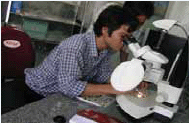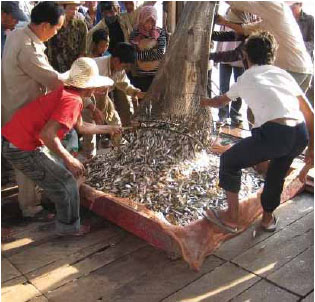Fisheries Programme

The huge fisheries of the Lower Mekong Basin are estimated to yield between two and three million tonnes of fish and aquatic animals each year. The Mekong River itself accounts for around 2% of the total world marine and freshwater capture fishery and supplies the bulk of animal protein for the basin population. These fisheries are thus immensely important, and joint management efforts by user communities and government agencies are required to protect and enhance their resources for future generations.
The MRC Fisheries Programme concentrates on knowledge generation, raising the awareness of fisheries in the Mekong, and improving their management, particularly by promoting community involvement in management processes. The goal is to achieve coordinated and sustainable development, utilisation and conservation of the basin’s fish resources. The programme has four components:
Fisheries Ecology, Valuation and Mitigation
The objective of this component was revised in April 2007 and
is now to ‘increase the capacity (knowledge, skills and tools)
of fisheries managers and relevant stakeholders to sustainably
manage the fisheries of the LMB in the context of the basin’s
integrated development’.
Over the course of the year robust estimates were published of basin-wide fish consumption, and from this estimates of yield were determined. Initiatives have been taken to institutionalise this estimation methodology. With the aid of fishers, a basin-wide ‘Fish Abundance and Diversity Monitoring Programme’ was established at 23 sites throughout the basin. A joint project with the WorldFish Centre began at sites in Thailand and Viet Nam to refine calibration aids for fish consumption estimation and to help interpret inter-annual variation in fish abundance. Monitoring of the dai and lee trap fisheries and fish larvae abundance continued to provide information on the health of the fishery.


Efforts continue to develop an improved model of forecasting the response of the basin’s fisheries resources to potential changes in water quality and hydrology, and to the creation of new barriers to migration. In August a project was implemented to consolidate and publish previous research on deep pool refuge habitat. This aims to improve understanding of how the quality, quantity and distribution of this critical habitat are likely to respond to basin development.
Fisheries Management and Governance
The aim of Fisheries Management and Governance activities is
to help resource users, line agencies and other organisations
develop and implement improved institutional arrangements and
technical measures for inland fisheries management. Work in
2007 focused on two main concerns: the importance of institutional
and organisational arrangements; and the linking of these arrangements
from local to national levels. These concerns were successfully
addressed through efforts in all four Member States to strengthen
the ability of communities and local authorities to enact mechanisms
that will make fisheries more sustainable. Due to the high demand
for capacitybuilding, innovative forms of provision have to
be identified and developed. One such innovation is the Local
Technical Network established in Soc Trang, Viet Nam, which
works to integrate water usage between shrimp and rice farmers.
The Technical Advisory Body for Fisheries Management continues to be the main conduit for strategy development, and in November 2007 the MRC supported its contributions to the Regional Consultation and Workshop on an ASEAN Fisheries Development and Management Mechanism, in Bangkok, and to the 8th Asian Fisheries Forum, in Kochi, India. Successful initiatives to raise funds for the implementation of local-level technical and organisational measures were accomplished in all the riparian countries, including at two sites in Viet Nam: the central highlands and the Mekong Delta.

Monitoring activities showed that in 2007,
64 dai fishing
boats in Cambodia landed over 18,000 tonnes of fish in
the Mekong.
Aquaculture of Indigenous Mekong Fish
Species
The aquaculture component focuses on the development of techniques
for propagation of indigenous Mekong fish species for fish farming
and stocking of water bodies. Research activities in 2007 focused
on four main areas:
- Breeding techniques;
- Nursery systems;
- On farm grow-out tests with private farms
The achievements of these research efforts over the year, conducted at both station and farm levels, will contribute significantly to aquaculture promotion and stock enhancement. Progress varied across the different activities and species used in various trials. With one species that is particularly tricky to reproduce, Cirrhinus microlepis, problems were experienced in trials in southern Lao PDR but a study in Viet Nam found that conditioning brood fish in concrete tanks results in better maturation of both males and females, plus improved quality and quantity of sperm.
Progress was also made in increasing the numbers of fingerlings of two species stocked in a reservoir in the Lao PDR, and in producing extension materials. Two CD-ROMs on fish propagation techniques were produced, and synopses on regional species were edited for local use. Work continued on genetic inventories of species in Thailand and Viet Nam, while around 2.5 million seeds from many indigenous fish species were produced for stocking and aquaculture in the Lao PDR.
Programme Management and Communication
Responsible for programme management and administration, this
component also coordinates the delivery of fisheries information
to target audiences. Numerous publications came out over the
last year including issues of the Catch and Culture newsletter
in English and the four languages of the riparian countries,
two MRC Technical Papers on fish migration in the Mekong and
fish consumption/yield in the LMB, plus various technical and
development series publications in both Thai and Khmer. Fisheries
films on Thailand and the Lao PDR were finalised in 2007 and
a book on fishing gears of the Mekong Delta in Viet Nam was
published.
Workshops were organised to further disseminate the results of specific programme activities, such as that held in Ho Chi Minh City on farmed catfish in the Mekong Delta (which now rivals the world-wide production of farmed Atlantic salmon). At another meeting, in Bangkok in September, the results from research into the 'barrage' type of fishing gear used in the Songkhram River Basin were presented to Thailand’s Inland Fisheries Research and Development Bureau.
Women play an important role in the Mekong's fisheries and gender equity in fisheries is one of the key social issues addressed by the Fisheries Programme, which makes regular contributions to the implementation of the MRC’s Gender Mainstreaming Strategy. The Annual Meeting of the Regional Gender and Fisheries Network was held in August, while programme staff participated in the MRC In-House Gender Mainstreaming Meeting in October and in the joint MRC/USAID project on Promoting Regional Cooperation in the Mekong River Basin in December.
Choose a newsletter: